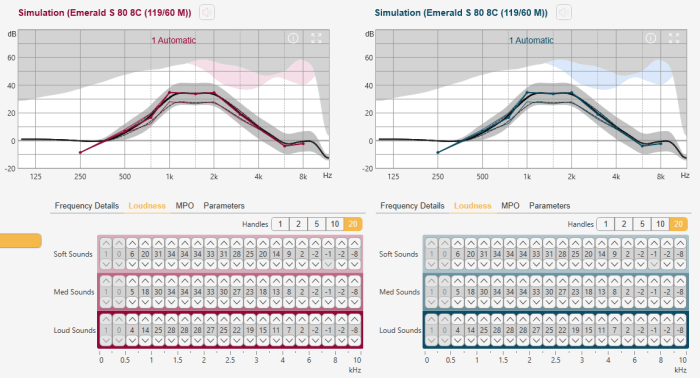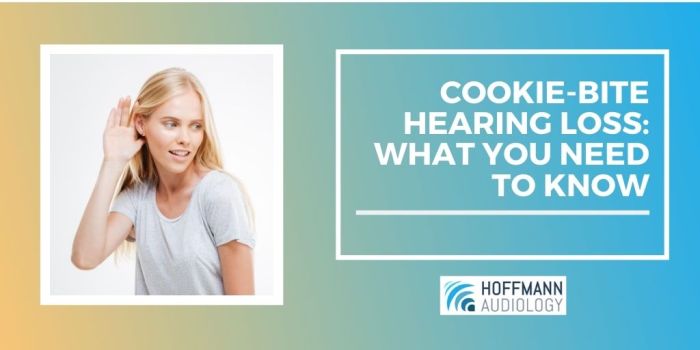Reverse cookie bite hearing loss, a distinct type of hearing impairment, manifests as an audiometric pattern resembling an inverted “cookie bite.” This unique presentation warrants exploration of its underlying causes, diagnostic methods, and effective management strategies.
Reverse Cookie Bite Hearing Loss: Definition

Reverse cookie bite hearing loss is a distinctive pattern of hearing loss characterized by a gradual decline in the perception of high-frequency sounds, while low-frequency hearing remains relatively unaffected. The audiometric representation of this hearing loss resembles an inverted “cookie bite” shape, with a sharp drop in the higher frequencies.
Causes of Reverse Cookie Bite Hearing Loss
The underlying causes of reverse cookie bite hearing loss can vary. Some of the most common include:
- Ototoxicity:Exposure to certain medications, such as certain antibiotics, chemotherapy drugs, and loop diuretics, can damage the cochlea, leading to reverse cookie bite hearing loss.
- Noise exposure:Prolonged or intense exposure to loud noise, such as industrial machinery or recreational activities like listening to music at high volumes, can also cause damage to the cochlea and result in reverse cookie bite hearing loss.
Diagnosis of Reverse Cookie Bite Hearing Loss
Confirming a diagnosis of reverse cookie bite hearing loss typically involves a comprehensive audiological evaluation. This may include:
- Pure-tone audiometry:This test measures the individual’s ability to hear sounds at different frequencies and intensities, revealing the characteristic “cookie bite” pattern of hearing loss.
- Speech audiometry:This test assesses the ability to understand speech in quiet and noisy environments, providing insights into the impact of hearing loss on communication.
- Imaging studies:In some cases, imaging studies such as magnetic resonance imaging (MRI) or computed tomography (CT) may be used to rule out underlying structural abnormalities that could contribute to hearing loss.
Management of Reverse Cookie Bite Hearing Loss
Treatment options for reverse cookie bite hearing loss depend on the underlying cause and the severity of hearing loss. Some common management strategies include:
| Type | Suitability |
|---|---|
| Behind-the-ear (BTE) | Moderate to severe hearing loss |
| In-the-ear (ITE) | Mild to moderate hearing loss |
| In-the-canal (ITC) | Mild to moderate hearing loss |
| Completely-in-the-canal (CIC) | Mild hearing loss |
In cases of severe hearing loss, cochlear implants may be considered. These devices bypass the damaged cochlea and stimulate the auditory nerve directly, providing improved hearing.
Prognosis and Prevention of Reverse Cookie Bite Hearing Loss
The prognosis for individuals with reverse cookie bite hearing loss can vary depending on the underlying cause and the severity of hearing loss. In some cases, hearing loss may stabilize or improve with treatment. However, in cases of significant damage to the cochlea, hearing loss may be permanent.
Prevention of reverse cookie bite hearing loss primarily involves avoiding exposure to ototoxic medications and loud noise. Regular hearing check-ups are also recommended to monitor hearing health and detect any early signs of hearing loss.
FAQs
What is the significance of the “cookie bite” shape in hearing loss?
The cookie bite shape refers to the distinctive audiometric pattern associated with reverse cookie bite hearing loss, characterized by a dip in hearing sensitivity at specific frequencies.
What are the common causes of reverse cookie bite hearing loss?
Underlying conditions such as Meniere’s disease, autoimmune disorders, and certain medications can contribute to the development of reverse cookie bite hearing loss.
How is reverse cookie bite hearing loss diagnosed?
Diagnosis involves a comprehensive audiological evaluation, including pure-tone audiometry and speech audiometry, to assess hearing thresholds and speech recognition abilities.

